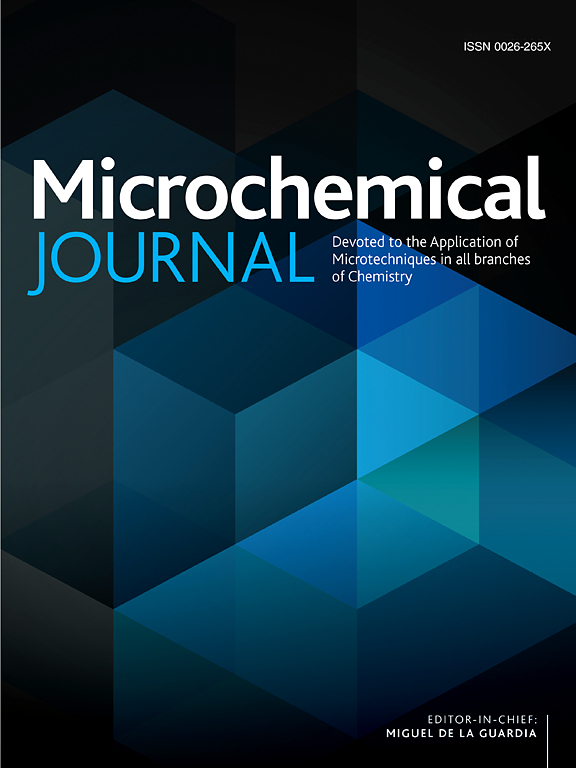Automated data exploration of α-pyrrolidinoisohexiophenone metabolites in Upcyte human hepatocytes reveals potential individual-specific metabolic profiles
IF 4.9
2区 化学
Q1 CHEMISTRY, ANALYTICAL
引用次数: 0
Abstract
Synthetic cathinones, a major class of new psychoactive substances, pose significant public health challenges due to their toxicity and frequent involvement in overdoses. However, detecting them in biological samples remains challenging because of their structural similarities and a lack of metabolic data. This study analyses the in vitro toxicity and metabolism of the synthetic cathinone α-pyrrolidinoisohexiophenone (α-PiHP) using Upcyte Human Hepatocytes (UHH) as hepatic cell model. Liquid chromatography coupled with high-resolution tandem mass spectrometry (LC-HRMS/MS) was employed to analyze both cell media and intracellular contents. An automatic data mining strategy was developed to identify putative metabolites based on predicted biotransformations, MS/MS spectral similarities among putative metabolites and the parent compound, and unique signals in treated samples. This workflow led to the identification of 10 Phase I metabolites. The most abundant metabolite in cell extracts was M1 (C16H25NO, α-PiHP ketone β-reduction), while metabolite M8 (C16H23NO3, α-PiHP dihydroxylation) predominated in the cell medium, suggesting their potential as biomarkers for α-PiHP consumption. Notably, interindividual differences in in vitro hepatic metabolism were observed across two donors, indicating idiosyncratic metabolic profiles, and underscoring the importance of human variability in drug metabolism studies and in forensic and clinical applications. In summary, these findings enhance our understanding of α-PiHP metabolism and may improve the detection of synthetic cathinones in biological and environmental samples.
upcell人肝细胞α-吡咯烷二异己烯酮代谢物的自动数据探索揭示了潜在的个体特异性代谢谱
合成卡西酮是一类主要的新型精神活性物质,由于其毒性和经常过量使用,对公共卫生构成重大挑战。然而,由于它们的结构相似性和缺乏代谢数据,在生物样品中检测它们仍然具有挑战性。本研究以Upcyte Human Hepatocytes (UHH)为肝细胞模型,分析了人工合成卡西酮α-吡啶烷二异己烯酮(α-PiHP)的体外毒性和代谢。采用液相色谱-高分辨率串联质谱(LC-HRMS/MS)对细胞培养基和细胞内内容物进行分析。开发了一种自动数据挖掘策略,根据预测的生物转化,假定代谢物与母体化合物之间的MS/MS谱相似性以及处理样品中的独特信号来识别假定代谢物。该工作流程鉴定了10个I期代谢物。细胞提取物中最丰富的代谢物是M1 (C16H25NO, α-PiHP酮β-还原),而代谢物M8 (C16H23NO3, α-PiHP二羟基化)在细胞培养基中占主导地位,表明它们有潜力作为α-PiHP消耗的生物标志物。值得注意的是,在两个供体中观察到体外肝脏代谢的个体间差异,这表明代谢谱的特殊性,并强调了人类差异性在药物代谢研究以及法医和临床应用中的重要性。综上所述,这些发现增强了我们对α-PiHP代谢的理解,并可能改善生物和环境样品中合成卡西酮的检测。
本文章由计算机程序翻译,如有差异,请以英文原文为准。
求助全文
约1分钟内获得全文
求助全文
来源期刊

Microchemical Journal
化学-分析化学
CiteScore
8.70
自引率
8.30%
发文量
1131
审稿时长
1.9 months
期刊介绍:
The Microchemical Journal is a peer reviewed journal devoted to all aspects and phases of analytical chemistry and chemical analysis. The Microchemical Journal publishes articles which are at the forefront of modern analytical chemistry and cover innovations in the techniques to the finest possible limits. This includes fundamental aspects, instrumentation, new developments, innovative and novel methods and applications including environmental and clinical field.
Traditional classical analytical methods such as spectrophotometry and titrimetry as well as established instrumentation methods such as flame and graphite furnace atomic absorption spectrometry, gas chromatography, and modified glassy or carbon electrode electrochemical methods will be considered, provided they show significant improvements and novelty compared to the established methods.
 求助内容:
求助内容: 应助结果提醒方式:
应助结果提醒方式:


